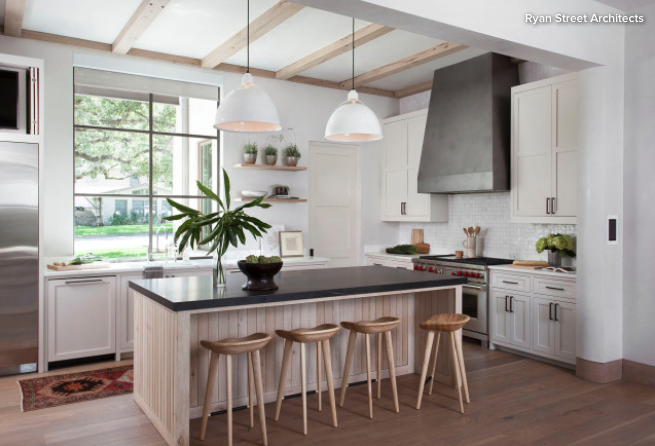
There are two actions that come to mind as being the most important in getting ready for a construction project: Avoid denial, and prepare. Everything you need to do falls under one of these two categories. But how, specifically, can you prepare for the first day of construction? Here are the basic steps.
1. Make a List of Items You Need to Have Onsite When Construction Begins
Have you ordered the sink and faucet? Do you have your appliance delivery scheduled? The reason for this is that once work starts, life gets a little more chaotic — OK, a lot more chaotic. Things like ordering a sink will slip through your fingers, and you’ll find yourself scrambling when the contractor asks for something.
2. Establish Expectations With Your Contractor
This isn’t just about telling the contractor what you expect, this is also about the contractor and other professionals letting you know what are realistic expectations. This will make for a happier client and a more pleasant process overall.
As the homeowner, you actually do have some control over the schedule. Taking too long to finalize decisions can cause significant delays.
Don’t forget to be nice to the neighbors and tell the contractor to do the same. Let the neighbors know you’re starting a construction project and that there will be crews around. Tell them to please let you know if they have issues. Noise, debris and blocking the street with deliveries are often issues that come up with neighbors.
Set up a recurring weekly construction meeting to touch base with your contractors and other pros. You may not need it every week, but at least it’s on the schedule in case you do.
Here are some things to consider and discuss with your contractor.
3. Empty Out Your Cabinets
So now that you’ve taken care of business, it’s time to get your hands dirty. Rather than dreading this, look at it as an opportunity to do some serious spring cleaning. Instead of throwing everything in a bunch of boxes and deferring the editing process to the end, get it done now to make moving back in that much more fun. However, if you’ve got too much on your plate to deal with this now, it can always be done later.
Put all the items you won’t need for a few months into boxes — or even better, big plastic bins with lids to protect the contents from dirt and dust. Separate out what you’ll want to use in your temporary kitchen: knives, coffee mugs, food you’ll eat and even a few wineglasses. Who says you have to drink out of plastic cups the whole time?
4. Set Up a Temporary Kitchen
The more organized and prepared you are in this area, the happier you’ll be. A half-hearted attempt at a temporary kitchen isn’t recommended. Even if you don’t have kids and plan to eat out every night, you’ll want a place to make a cup of coffee or a snack.
I think two tables are ideal, and if you have the room, two tables plus the kitchen table for seating. If you don’t have an old table, pick up a few folding tables — 24 or 30 inches deep by whatever length you can fit (not the 48-inch square ones, which are too deep to use as countertops). If you’re using a table from the house, get a plastic-coated tablecloth to protect it.
Think about setting up your temporary kitchen the way you would a real kitchen, in stations.
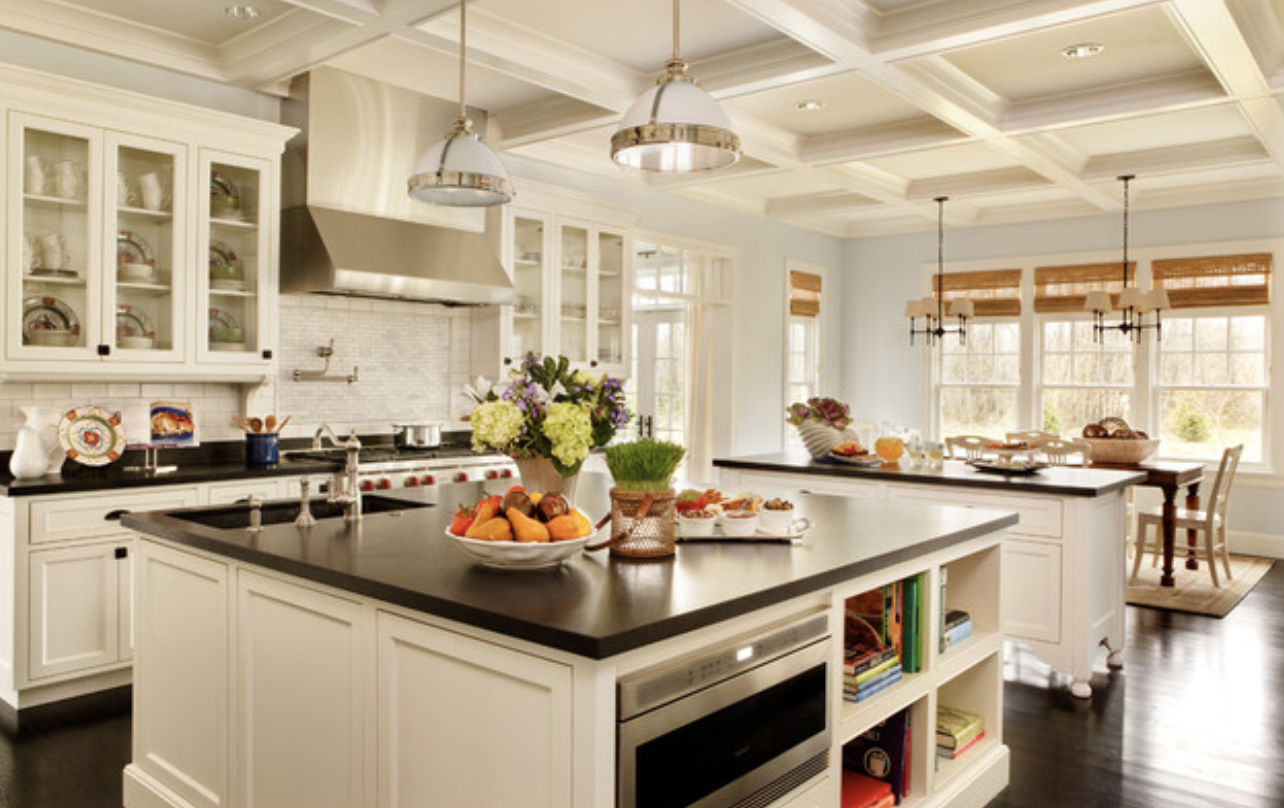
This natural stone has been around for thousands of years, and it comes in myriad color options to match any kitchen
Granite, the same stone that portions of ancient Egyptian pyramids are composed of, is ubiquitous in the kitchen for good reason. This stout stone that can weather millennia easily stands up to kitchen use and abuse. Is granite right for your kitchen? Have a look.
What to Know About Granite Countertops
The basics: Granite is a natural stone, composed of at least 20 percent quartz as well as mica and feldspar. Colors choices span the rainbow, from a monochromatic slab to bold patterns. Countertop finish options include:
Advantages: Granite is tough to beat when it comes to durability, due to its heat- and scratch-resistant qualities; it can bear up to 1,200 degrees Fahrenheit. Granite can also be stain and water resistant when it’s properly sealed. Those seeking an unusual slab or a unique pattern will not be disappointed with the seemingly limitless choices.
Disadvantages: Installation can get tricky due to granite’s hefty nature. And if you choose some of the more exotic slabs, costs can quickly escalate.
Sustainability: Granite’s durability means this product can outlast you and even your home. However, mining stone does disrupt local ecosystems and depletes finite, nonrenewable resources. Ecofriendly granite can be had with salvaged slabs. Also, you can choose granite that’s mined in your region to reduce transportation-related energy costs.
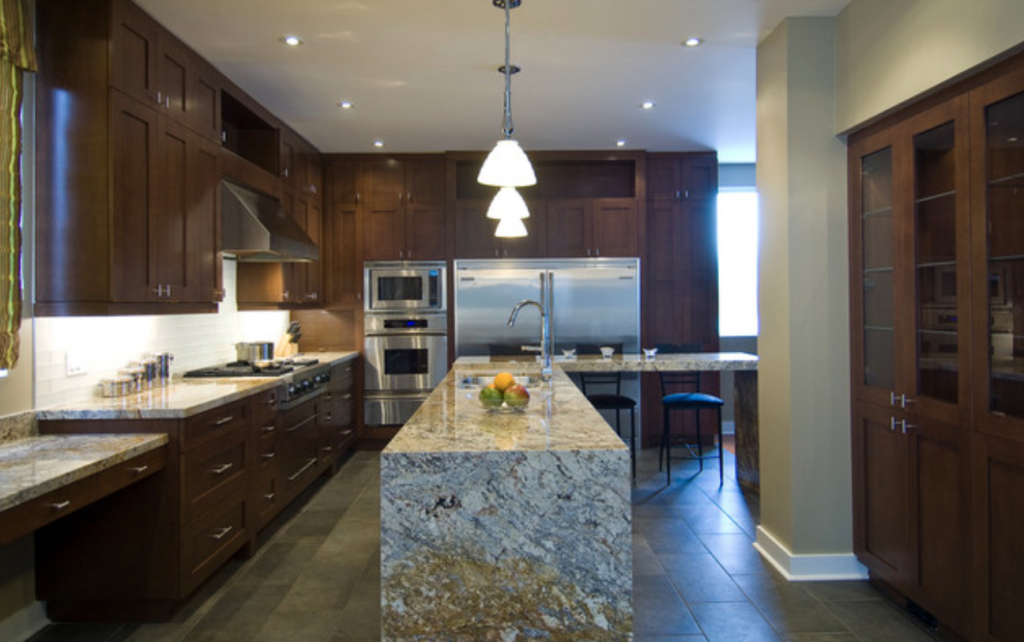
Maintenance: Limit routine care to a soft cloth and warm water or cleansers made specifically for granite. You’ll want to seal your slab every year or two with an impregnating water-based sealer made for granite.
Special considerations: You might have heard questions about radon content in granite.The U.S. Environmental Protection Agency has concluded that there is little or no health threat from granite counters, due to their relatively low radon content. You can read more here.
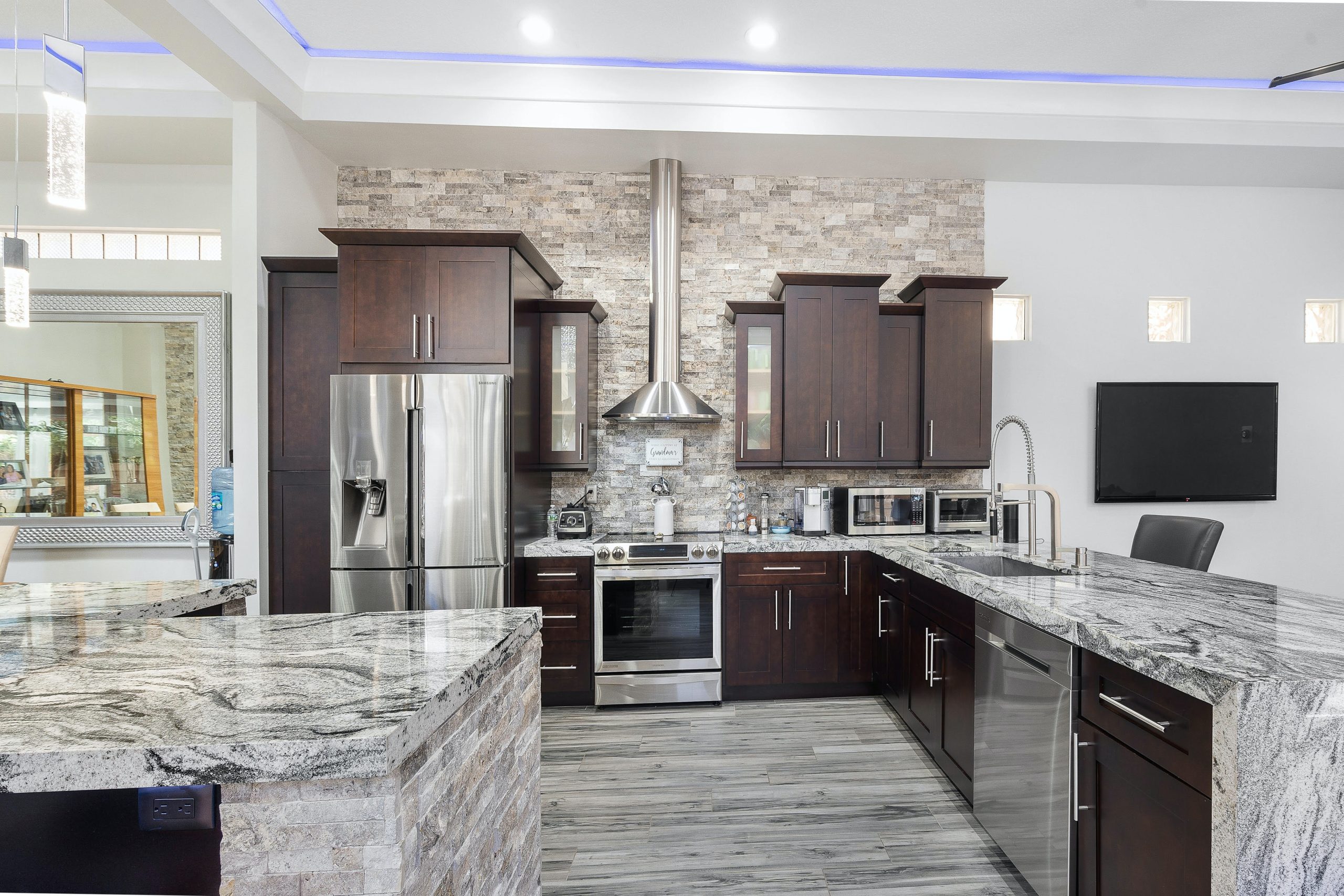
There’s a reason everyone “oohs” and “ahhs” over granite countertops—they have timeless style and durability to boot. No matter the reason for the upgrade (remodel, damage, new home), granite is a surface that can bring value and beauty to whatever space you choose. Keep reading to learn the seven key benefits of choosing granite countertops for your next kitchen remodel.
Unlike synthetic countertops, granite is created by nature. Each granite slab has unique fissures, swirls, and flecks of shiny iron bits. There may be 10 slabs at a showroom—all from the same quarry—with wildly varying characteristics. If you have a granite countertop in your kitchen, you know you have a piece that is truly one-of-a-kind.
Quality kitchen elements like granite counters make your space look more high-end and updated. Granite counters attract potential buyers, as they know they’re getting something they won’t have to update when they move in. The more turnkey a home is, the higher its value will be.
Different countertops have different prices, care requirements, and durability. Granite has a very high hardness rating. This means it can stand up to scratches and accidents better than other options (especially marble). For active families and busy kitchens, this is an exceptionally valuable feature.
When considering natural stone versus synthetic stone countertops, natural stones like granite are the more sustainable option. This is because they require minimal processing before they make it to your kitchen. Synthetic materials call for a lengthier and more complex production process, which may include toxic chemicals and releasing harmful emissions into the atmosphere.
Though granite countertops are highly resilient, accidents happen. Luckily, even if your granite counters get cracked or chipped, they are usually repairable. A countertop repair pro near you can often use filler materials to get your granite looking good-as-new again. If a heavy pot slips from your hands, or if a glass jar falls from your cabinet, it’s nice to have that extra peace of mind.
When choosing the right countertop, you can’t go by looks alone. You’ll also need to consider how well it’ll hold up against spaghetti sauce, red wine, or other spills. It’s also important that countertops don’t absorb all the icky germs and bacteria from raw meat during meal prep. Provided they get sealed properly at least once a year, your granite counters will wipe clean of all these messes.
Since granite gets formed naturally via pressure and heat, granite counters have built-in heat resistance. While it’s still a good idea to use potholders, you won’t have to worry about the scorching you’d get with other countertop varieties. Get in touch with a top-rated countertop installer near you to learn more.
If you’re shopping for natural stone countertops, you’ve probably considered granite and quartz varieties. While both of these stones are extremely durable, the biggest difference between quartz and granite is that granite stays true to its color the longest. Quartz can become discolored over time if left in direct sunlight. If you have a skylight in your kitchen, or just a lot of natural sun coming in, this is definitely something to think about
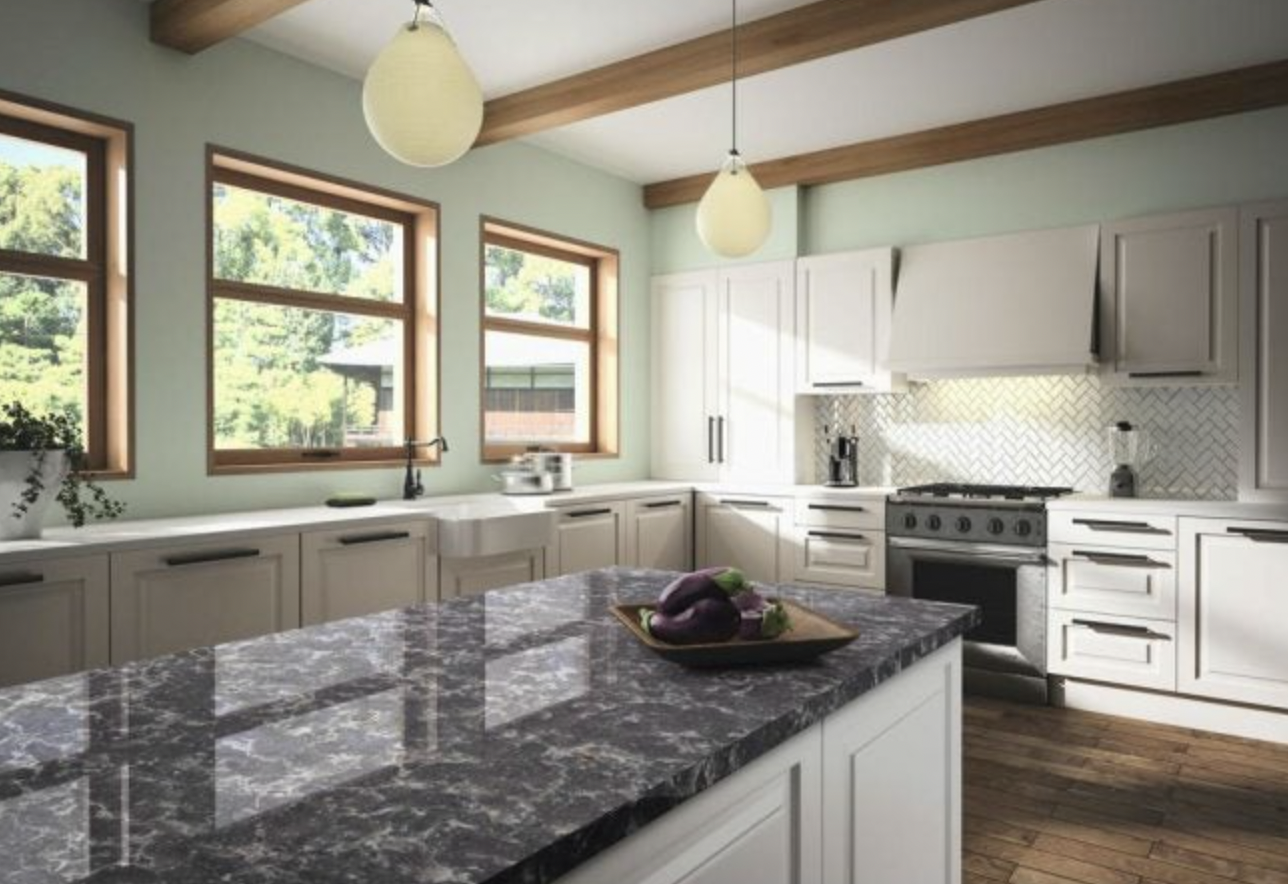
Beautiful, hygienic, and low-maintenance, engineered stone makes an ideal eco-friendly countertop surface.
Many new homeowners nowadays care about making eco-friendly choices. And when it comes to countertops, engineered stone is one of the most environmentally sensitive choices you can make. An alternative to natural stone cut from pure marble or granite, this factory-made composite features crushed stone (often quartz crystals in countertops and marble in wall and flooring products) bound in slab form with an adhesive or resin. In fact, because of the high percentage of quartz crystals found in countertops, the material is often simply called quartz.
Slabs used in the kitchen should be acid-resistant and non-absorptive, and a variety of products on the market made with crushed quartz crystals—including options from cambria, Silestone, Caesarstone —fit the bill. Most engineered stones are fantastic for high-wear uses such as kitchen countertops. The types and sizes of the components used to make the engineered stone that will determine its best uses. An engineered surface with large chunks of marble, for example, will be limited in performance to the pieces of marble it contains.
Unlike solid surfacing or plastic laminate, which are temperature-sensitive and can catch fire, engineered stone resists heat well. And unlike some other surfaces—even natural stones—engineered ones resist stains from liquids like wine or coffee.
Strong, durable, and attractive, engineered stone is very consistent in look and pattern. The non-porous surface is easy to maintain and heat-resistant, too. Some products can be specified as bacteria-resistant and not others, but since all are non-absorptive and resistant to heat, they should not be collecting bacteria in the first place.
Beyond brute strength and heat resistance, these man-made products come in a myriad of shades and styles. Some engineered stones are made to look like limestone or marble, enabling you to get the natural coloring and texture you want but with better performance. This also makes engineered stone counters a fine stand-in when you prefer to use recycled materials or protect natural resources like real marble. Plus, many contractors are familiar with the products and will install them properly.
It’s hard to create curves with engineered stone, but as far as typical countertop designs go, there’s nothing you can’t do with these products that you can accomplish with conventional stone. In fact, we’ve pushed the limits with edge and corner details and other shapes in engineered stone materials.
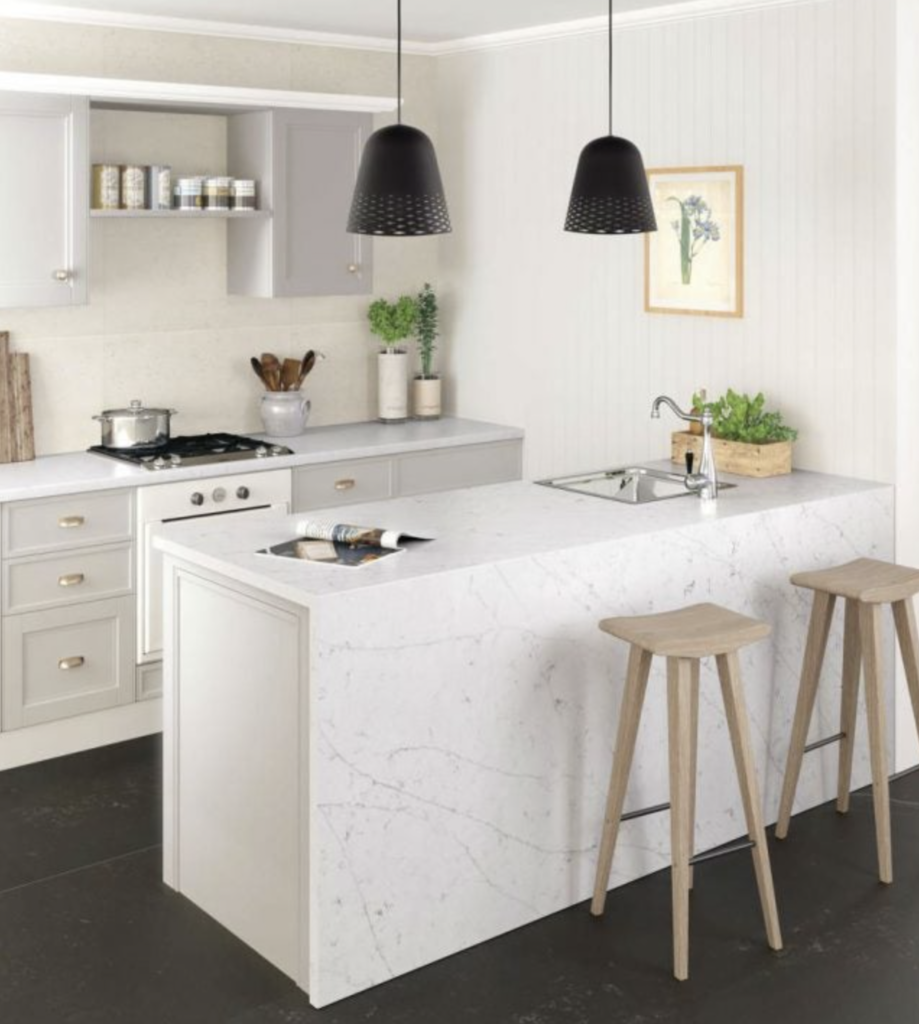
Generally about $60 to $100 per square foot installed.
With engineered stone, you pay for good performance and a long lifetime. Some colors and patterns are more expensive than others, but others can be quite affordable (I even put one of these in my own house).
Plus, while it’s expensive—definitely more so than plastic laminates—no more so than many natural stone slabs and solid surface materials. But consider this: For years we were specifying white marble with no veins, which looks great but is very expensive. Now to get that white look, we can use engineered stones, which look exactly the same as marble side by side but don’t cost as much. There are lots of suppliers, and the product delivers a consistent look.
Stay connected with all the latest trends in Kitchen & Bath! Sign up for our FREE Granite Buyers Club